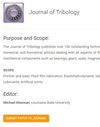Thermohydrodynamic Analysis of a Controllable Stiffness Foil Bearing with Shape Memory Alloy Springs: Experimental Tests and Theoretical Predictions
IF 3
3区 工程技术
Q2 ENGINEERING, MECHANICAL
引用次数: 0
Abstract
Abstract Shape memory alloy (SMA)-gas foil bearings (SMA-GFBs) are novel gas bearings constituted of top foil, SMA springs and housing. The radial clearance, stiffness and damping coefficients of SMA-GFBs can be controlled by the bearing temperature which is determined by the electric heating of SMS springs and the cooling air. A 3D thermohydrodynamic model (THD) with the consideration of the conduction and convection of top foil, bearing housing and hollow rotor and heat energy of heated SMA springs is presented to simulate the temperature distribution of SMA-GFBs at different rotational speeds, heating powers and cooling flows. A test rig is built to measure the SMA-GFB temperature and to validate the effectiveness of the theoretical model and circumferential cooling mode. Parametric studies are conducted with different speeds, heating powers and cooling flows. Heat transfer ratios of rotor and substructure are also compared. Compared with the temperature difference of bearing temperature in the circumferential or axial direction, the influence of rotational speed and cooling flow on bearing temperature is very obvious. The phase transition process of SMA spring can be controlled by adjusting the rotor speed and the cooling flow reasonably, and then the temperature characteristics of SMA-GFB can be changed. The temperature generated by compressed gas film and heated SMA springs and cooling mode can be adjust to validate the feasibility of active changing the performance of bearing-rotor system.形状记忆合金弹簧可控刚度箔形轴承的热流体力学分析:实验测试和理论预测
摘要形状记忆合金(SMA)-气体箔轴承(SMA- gfbs)是一种由顶部箔、SMA弹簧和外壳组成的新型气体轴承。SMA-GFBs的径向间隙、刚度和阻尼系数可由轴承温度控制,轴承温度由SMS弹簧的电加热和冷却空气决定。针对SMA- gfbs在不同转速、加热功率和冷却流量下的温度分布,建立了考虑顶部箔片、轴承壳和空心转子的传导和对流以及SMA弹簧加热热能的三维热流体力学模型(THD)。建立了SMA-GFB温度测试平台,验证了理论模型和周向冷却模式的有效性。在不同的速度、加热功率和冷却流量下进行参数化研究。还比较了转子和子结构的换热比。与轴承温度在周向或轴向的温差相比,转速和冷却流量对轴承温度的影响非常明显。通过合理调节转子转速和冷却流量,可以控制SMA弹簧的相变过程,从而改变SMA- gfb的温度特性。压缩气膜和加热SMA弹簧产生的温度和冷却方式可以调节,以验证主动改变轴承-转子系统性能的可行性。
本文章由计算机程序翻译,如有差异,请以英文原文为准。
求助全文
约1分钟内获得全文
求助全文
来源期刊
CiteScore
4.20
自引率
12.00%
发文量
117
审稿时长
4.1 months
期刊介绍:
The Journal of Tribology publishes over 100 outstanding technical articles of permanent interest to the tribology community annually and attracts articles by tribologists from around the world. The journal features a mix of experimental, numerical, and theoretical articles dealing with all aspects of the field. In addition to being of interest to engineers and other scientists doing research in the field, the Journal is also of great importance to engineers who design or use mechanical components such as bearings, gears, seals, magnetic recording heads and disks, or prosthetic joints, or who are involved with manufacturing processes.
Scope: Friction and wear; Fluid film lubrication; Elastohydrodynamic lubrication; Surface properties and characterization; Contact mechanics; Magnetic recordings; Tribological systems; Seals; Bearing design and technology; Gears; Metalworking; Lubricants; Artificial joints

 求助内容:
求助内容: 应助结果提醒方式:
应助结果提醒方式:


